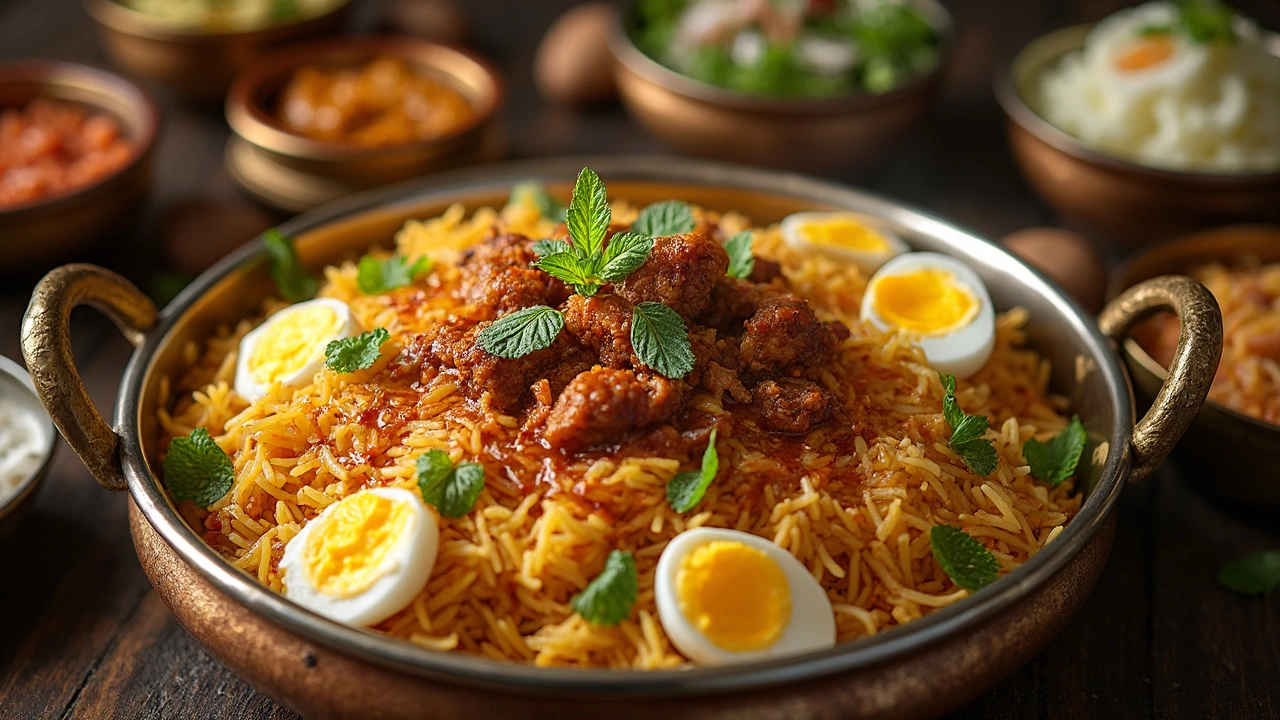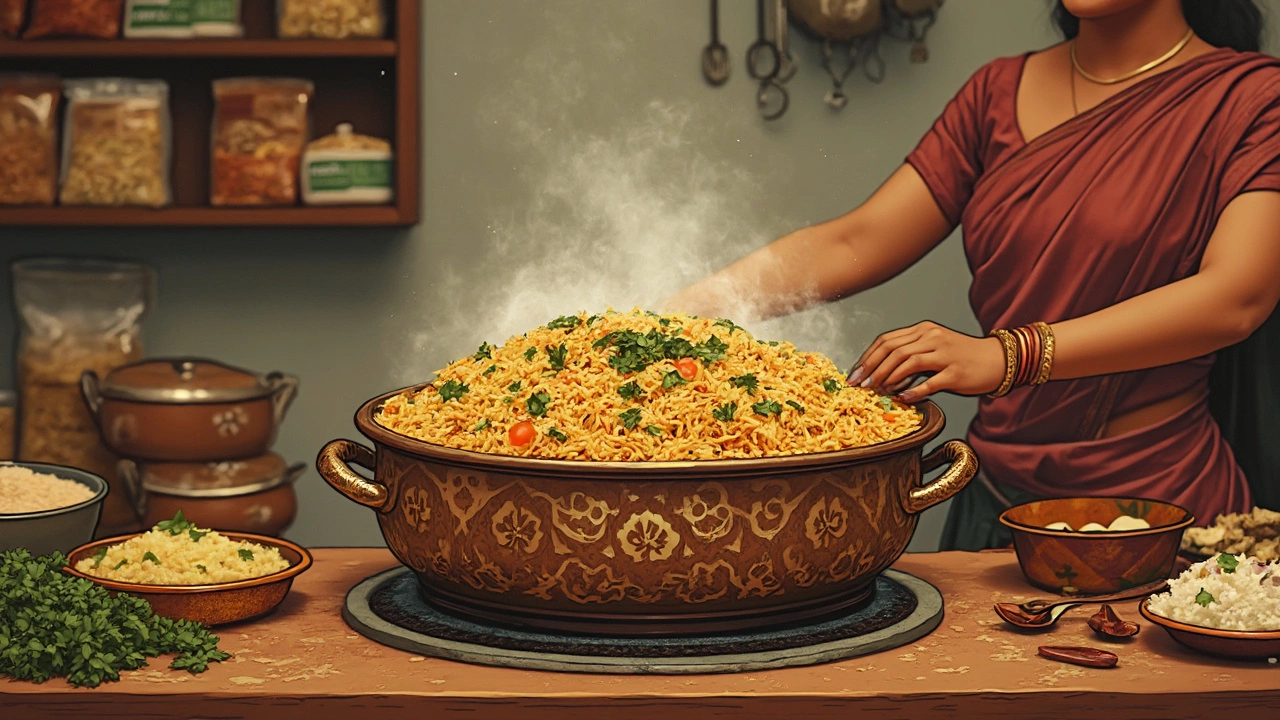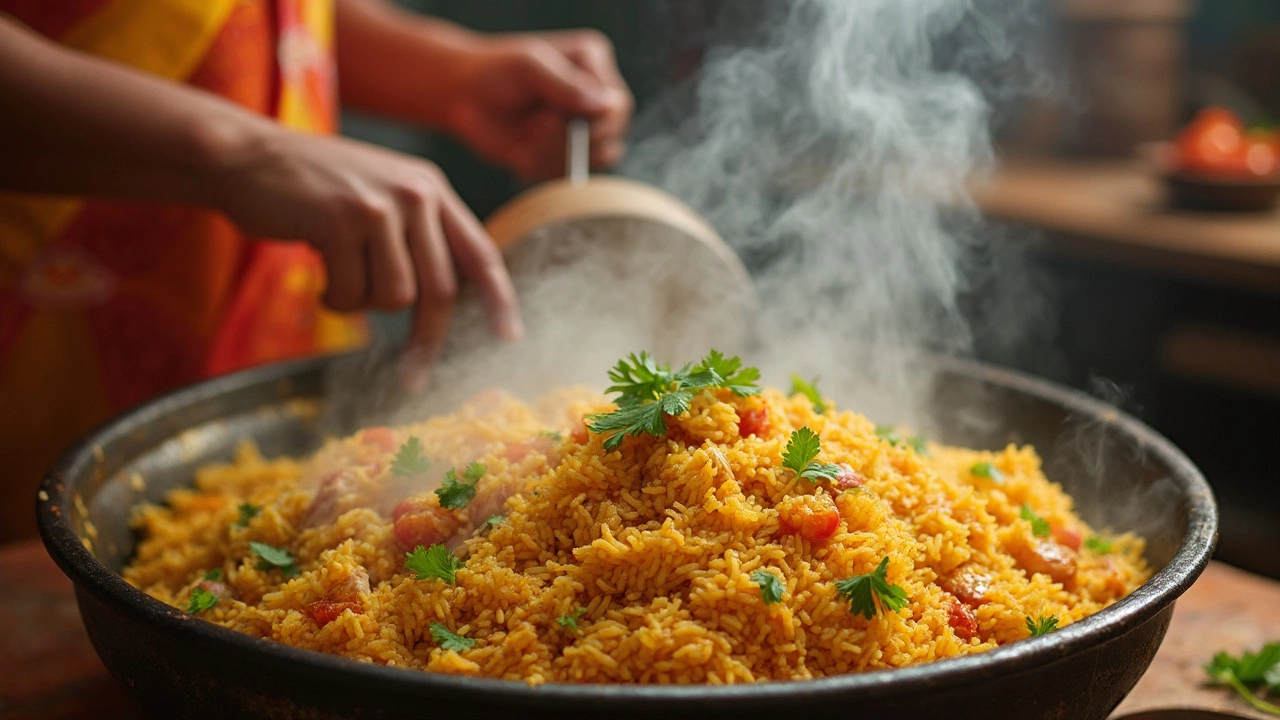Ever lifted the lid on your biryani and felt a wave of disappointment at the sight of dry, clumpy rice? You’re not alone. Juicy biryani is the dream, but most people don’t realize how easy it is to lose all that lovely moisture—and all the flavor. The magic of biryani comes down to the right balance of moisture, rice, and the way everything is put together.
The truth? One wrong move with the rice or skimping on gravy, and you’re left with something closer to fried rice than biryani. But if you want soft, flavorful grains and juicy pieces of meat or veggies, you’ve got to pay attention to a few key details. Once you know what to look out for, those perfectly juicy layers are much easier to pull off. No more serving biryani with a side of apologetic smile—just compliments and empty plates.
- What Makes Biryani Juicy Anyway?
- Choosing the Right Ingredients
- How to Cook and Layer for Maximum Juiciness
- Secrets of the Dum: Locking in Moisture
- Common Mistakes that Dry Out Your Biryani
What Makes Biryani Juicy Anyway?
Most folks think it’s just the amount of water or oil, but juicy biryani is really about how everything gets layered and steams together. You want each grain of rice to soak up just enough moisture without turning mushy. Traditionally, the biggest factor is the balance between rice that’s almost cooked (but not quite) and flavorful, saucy meat or veggies. When you combine them right and trap the steam (the famous ‘dum’ method), the juices from meat or vegetables mingle into the rice, locking in a juicy bite every time.
Let’s break it down further—why does some biryani turn out dry while others are so moist you want to eat three plates? A lot comes down to these basic elements:
- Juicy biryani depends mostly on gravy—also called 'yakhni'—made with onions, tomatoes, yogurt, and the natural juices from chicken, lamb, or vegetables. Too little yakhni, and the rice sucks up everything, leaving it dry.
- The cooking method matters a ton. The sealed-pot (‘dum’) technique helps steam circulate, so the moisture stays trapped. In open pots, much of the steam escapes, and dry biryani happens fast.
- The rice matters! Basmati is classic, but it needs to be par-boiled (about 70% cooked). Fully cooking rice first often leads to mush, while undercooked rice stays uncooked even after the final steam.
Are you a numbers person? Here’s a quick look at how moisture can change after dum cooking:
| Factor | Ideal Level | Effect on Juiciness |
|---|---|---|
| Yakhni (gravy) | 1 - 1.5 cups per 500g meat | Keeps grains moist, infuses flavor |
| Rice water absorption | 70% boiled (firm, not soft) | Prevents mush and helps soak up the juices |
| Dum time (steaming) | 20-30 minutes on low heat | Locks in steam, melds flavors |
One simple test: lift a little biryani with your spoon—if the grains look shiny and you see tiny clumps of moist rice sticking together, you nailed it. If it falls apart dry, time to adjust your method. Keeping your eyes on these specific steps and not cutting corners is what separates dry biryani from the showstopper, super moist kind that disappears at every party.
Choosing the Right Ingredients
Picking your ingredients for biryani isn’t just about what’s on sale—this step really makes or breaks the juiciness. Let’s face it, you can’t get juicy biryani by cutting corners on the basics. The kind of rice, your protein, the veggies, and even what goes in your marinade matter way more than people think.
If you’re after that classic mouthwatering effect, start with long-grain basmati rice. Don’t grab just any old rice off the shelf. Top brands like Daawat and India Gate are famous for a reason—their grains actually stay separate and fluffy but soak in all the flavor without turning mushy. Here’s a quick reference for the right rice-to-meat ratio and key ingredient moisture content, which keeps things juicy every time:
| Ingredient | Ideal Type/Ratio | Moisture Booster? |
|---|---|---|
| Basmati Rice | 1 part to 1.25 parts meat (by weight) | No, absorbs moisture |
| Meat (Chicken/Lamb) | Bone-in, skin-off chunks | Yes, bones add juiciness |
| Yogurt | 1/2 cup per pound of meat | Yes |
| Onion | 2 medium per 2 cups rice | Yes, caramelized onions add both flavor and moisture |
| Tomato | 1 medium per pound of meat | Yes |
Bone-in protein like chicken or goat is a game-changer for juicy biryani. The bones release extra juices while cooking, which mix with the rice as everything steams together. If you’re making a veggie version, don’t skip mushrooms and potatoes—these both hold and release moisture as they cook. And for the marinade, always add full-fat yogurt. It helps tenderize, creates that rich sauce, and bumps up the moisture where it counts the most.
Spices matter for taste, but the big moisture lifters are ingredients like fried onions and tomatoes. Fried onions literally melt into the biryani as it cooks, spreading out their sweetness and fluids. Tomatoes not only add tang but also keep things from ever going dry. Don’t be afraid to use fresh ginger-garlic paste either, as it breaks down proteins and turns everything more succulent.
Summing it up? Think about how each ingredient handles moisture before you toss it in the pot. Smart picks early on make it much easier to get a juicy biryani that everyone will be talking about long after dinner’s over.

How to Cook and Layer for Maximum Juiciness
If you want biryani that’s bursting with flavor and moisture, the way you cook and layer matters a ton. The real secret? Each layer needs some gravy. No dry spots, no shortcuts.
First, focus on the rice. Parboil it—don’t fully cook it. Perfect rice should be about 70% cooked. When you press a grain between your thumb and finger, it should split but stay holding its shape. Overcooked rice soaks up all the gravy and just turns mushy.
- Always drain boiled rice right away so it doesn’t keep cooking in its own steam.
- Rinse your rice before you cook. This is not just to clean—it removes extra starch so grains don’t stick together and form clumps.
Now, let’s talk about the key step: layering. Forget just dumping everything together and hoping for the best. A classic biryani is built in layers for a reason. Here’s how most home cooks nail juicy biryani every single time:
- Start with a little oil or ghee at the bottom of your pot to stop anything from sticking.
- Add half your meat (or veggie) gravy. This isn’t just for flavor—it’s what makes the bottom layers so moist.
- Spread half the parboiled rice over the gravy. Don’t press it down—let it stay loose.
- Drizzle a bit more gravy or even a few spoons of warm milk mixed with saffron over the rice for added moisture (that’s an actual chef trick).
- Repeat with the rest of the meat/veggie gravy, then the rest of the rice.
- Top your layers with fried onions, a splash of rose water (if you like a floral hit), and small blobs of ghee.
How much liquid should you really use? Here’s a quick look at a typical ratio that works for home cooks making 1 kg of biryani:
| Ingredient | Amount |
|---|---|
| Rice (uncooked) | 500g |
| Meat or veggies | 500g |
| Gravy/liquid (from marination or cooked sauce) | 250-300ml |
The key is not to flood the dish—just enough liquid to steam through the rice but not so much that it pools at the bottom. Too much liquid and you’ll get mush, not biryani. Too little and forget about juicy biryani.
Don’t forget: cover the pot with a tight lid or even a layer of dough clamped around the rim. This locks the steam in and lets the moisture do its job. And when you finally lift that lid—no need for prayers, just trust the process—you’ll smell real biryani, not just cooked rice.
Secrets of the Dum: Locking in Moisture
Here’s where most folks either hit gold or totally miss the mark: the dum step. Dum is basically sealing up your biryani and gently steaming it so that all those flavors and juices stay locked in. Sounds simple, but it’s honestly one of the most important (and often messed up) parts of the whole thing.
If you ask anyone who cooks biryani regularly, they’ll tell you that how you seal your pot makes all the difference. Classic kitchens use dough (called atta) to completely line the pot’s rim before putting the lid on. No dough? Try a tight-fitting lid and then a layer of foil. The idea is to trap every bit of steam that gets created inside. That steam is pure gold because it’s packed with the aroma and moisture your biryani needs.
Let’s talk temperature. Too much heat, and your biryani dries out; too little, and it doesn’t cook through. The sweet spot is low and slow—usually 20–30 minutes. If you’re keeping track, a good target is to cook on very low heat so that the pot gently hisses but doesn’t whistle or rattle.
- Add 2–3 tablespoons of reserved marinade or plain water on top of the biryani before sealing. That bit of extra liquid soaks into the rice, making it softer and more juicy biryani every time.
- Try sprinkling some fried onions or a bit of saffron-milk on the top layer—this boosts both flavor and moisture.
- Layer some tomato slices or cooked veggies on top; they give up their juices as they steam, which soaks perfectly into the rice.
- If you’re worried about burning, place a tava (flat skillet) under your pot. It distributes the heat and stops those dreaded burnt bits.
Ever wondered if these steps actually help? Here’s a quick snapshot based on my weekend kitchen experiments last year. Luna, my golden retriever, didn’t complain, but my cousins sure did when I forgot the dum step.
| Sealing Method | Moisture Retention (estimated %) |
|---|---|
| Atta/dough sealed lid | 90% |
| Foil and tight lid | 85% |
| Loose lid only | 60% |
So next time you’re finishing your biryani, put a little extra effort into the dum. It’s honestly the most reliable way to keep everything juicy, full of flavor, and impossible to resist at the dinner table.

Common Mistakes that Dry Out Your Biryani
Most biryani fails are just basic slip-ups that pile up. Let’s call them out so you can dodge a dry disaster. Here are the biggest culprits I see in kitchens everywhere:
- Overcooking the Rice: Boiling the rice until it’s fully cooked before layering is probably the #1 way to end up with dry, mushy grains. For juicy biryani, your rice should be only 70% cooked before it goes into your biryani pot. That way, it finishes cooking by soaking up all the flavorful steam and juices.
- Not Enough Gravy or Marinade: Dry meat or veggies mean dry biryani. Always make sure your meat or veggies are marinated well and that you have a generous amount of masala (the spicy onion-tomato base) in every layer. This is where all the moisture comes from.
- Skipping Ghee or Oil: Ghee and oil are not just for flavor—they lock in moisture between the rice grains. Skipping or skimping on this step can make the whole thing taste flat and dry.
- Poor Layering: Shoving all the rice in first and dumping the gravy on top is just setting yourself up for uneven texture. Always alternate layers of rice and curry, so every bite gets some juiciness.
- Not Enough Dum (Steaming): Dum cooks the biryani in its own steam, sealing in every bit of moisture. If you rush this last step or keep opening the lid, you let all the steam escape—and take the juice with it.
- Not Using a Heavy-Bottomed Pot or Tight Lid: Thin pans burn easily, and loose lids let moisture escape. A heavy-bottomed pot with a snug lid is your best kitchen buddy here.
Let’s check out some actual numbers that can help you hit the sweet spot the next time you make biryani:
| Mistake | Consequence | Quick Fix |
|---|---|---|
| Rice cooked 100% before dum | Dry, hard texture | Cook rice only 70% |
| Not enough gravy (less than 1 cup per kg meat/veggies) | Dry biryani, bland flavor | Add extra masala or a splash of stock |
| Skipping ghee/oil | Sticky, dry rice | Use at least 2 tbsp per kg rice |
| Opening the lid during dum | Loss of steam and moisture | Keep the lid sealed for 20–30 minutes |
| Thin or nonstick pan | Burns, uneven cooking | Heavy-bottomed pan only |
Bottom line: Good biryani is all about those small details. Avoid these classic errors, and hitting that perfect, juicy texture isn’t a far-off dream at all.
